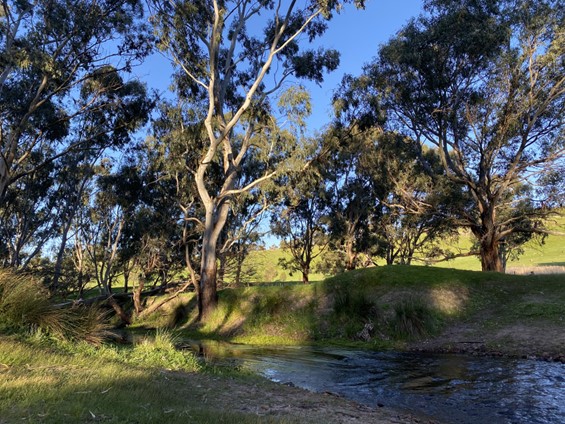
Connection to place, the value of green
In the previous blog of this series exploring the promise of regenerative education, I indicated that there was hope for the future, however the window for action is narrow and closing quickly. A brief analysis of the impact of the permacrisis on young people’s mental health was provided, followed by support mechanisms for wellbeing. I also considered how student agency (action) and empowerment (taking charge of their learning) supported the notion of ‘flourishing’ which incorporates involvement, engagement and student led learning to support young people’s wellbeing.
In this blog the importance of ‘place-based education’ and connection to country as positive influences on physical and psychological health will be outlined. In this time of crisis we need to look backward to see the path forward, with Indigenous connection to country and ways of knowing offering systematic solutions to our most wicked problems.

Figure 1. Image author’s own
This is my happy place (see Figure 1), where I feel connected to country. This place resonates with me, and I genuinely feel at peace when I am here. If conditions allow, I sit quietly, observing, taking in the fine detail. There are normally dozens of kangaroos on the hill, magpies and parrots in the trees, red gums that have stood for hundreds of years, with stones and water ribbons in the river. I think about the water, where it has come from and where it is going and the many kilometres it travels to meet the sea. After a period of observation, I normally lie on the ground arms outstretched, close my eyes, and just listen to the sounds that surround me. It may only be for five minutes, however the benefits afforded by this time to connect are so much longer lasting. I cannot confirm with scientific data only observational experiences that in the weeks when I was walking over 6 kms per day in nature and connecting with country, I slept much better and had better overall cognitive function.
I was introduced to this concept of connecting with place while reading The Dreaming Path written by Paul Callaghan with Uncle Paul Gordon. Callaghan (2023, pp. 1,3) asks you to ‘imagine a world with no war…no crime…no homelessness…no hunger…and no poverty. Where every person has all they need to live, a long life of fulfillment and wellbeing…The many things Aboriginal culture has given me, have enabled me to achieve a state of mind, body, and spiritual wellness.’ Callaghan (2023) discusses how connecting with Indigenous culture helped him heal from major depression. He suggests that reflecting on Indigenous cultural insights provides a means to ‘build your own capacity to do things that will generate personal growth, greater meaning and increased contentment (inwards perspective) and make your street, your community, your nation and the world a better place for current and future generations (outward perspective)’ (Callaghan 2023, p. 9).
Perhaps John Lennon, when writing his iconic song Imagine, was connecting with ancient Japanese culture, including the influences of Zen and Haiku (Kanji 2020). One commentator suggests that Lennon ‘particularly liked haiku that reflected the spirit of Zen—moving poems that viewed the self as a small part of the wider universe, and aimed at a kind of loving union with nature’ (Kanji 2020). Indeed, many Indigenous wisdoms, including eastern philosophy, offer perspectives on inner reflection and the ongoing connection of humans with nature.
Wen and colleagues (2019) examined human health efficacy and benefits of the Japanese practice of Shinrin-yoku (forest bathing) on sub-health (the state between health and disease). In response to worldwide increases in sub-health, the term ‘Shinrin-yoku’ was created in 1982, referring to ‘a healing technique that restores the physical and psychological health of the human body through a “five senses experience” (vision, smell, hearing, touch and taste) when the body is exposed to the forest environment’ (Wen et al. 2019, p.1-2). They suggest that forest bathing has positive effects on human health by enhancing immunity, treating chronic diseases, regulating mood, and reducing anxiety and depression. Wen et al.’s (2019 pp. 4-16, inclusive of tables) systematic review of the medical literature on forest-bathing found that the practice has positive physiological effects including a reduction in blood pressure and heart rate, a decrease in cortisol and adrenalin (fight or flight hormones) and lower triglycerides (‘bad’ fats that can cause heart disease). Psychologically, heightened emotional states including depression, anxiety, fatigue, confusion, anger and hostility were significantly decreased, with two studies suggesting that forest bathing significantly improved positive emotions and decreased negative emotions.
The inner and outer (systems) relationship in sustainability
As discussed previously, both Gallagher (2023) and Wen et al. (2019) describe how inner reflection ‘cultures, capacities, beliefs, values, and physical health’ are intrinsically linked to the outer environment. The understanding of this often-complex relationship requires systems awareness, recognition that changes in one will influence the other, that both are connected to each other and without inner reflection change is unlikely to follow. This is an example of systems theory where feedback loops need to be considered. Spain (2019, p. 135) defines systems thinking as ‘a dynamic framework for describing, assessing and explaining how a person and world function together in human development…it is conducive to a holistic, organismic approach to curriculum modelling, pedagogy and problem solving’. Cooper and Gibson (2022 pp. 1-2) suggest that there is
Growing interest in leveraging inner capabilities, including mindsets and world views, values, and beliefs for sustainability transformations. These have emerged from concerns that conventional approaches such as reductionist scientific solutions are failing to align social and ecological systems….the inner capacities have been ignored or underdeveloped which has meant that the solutions which were intended to fix the sustainability challenge can undermine the conditions of sustainability…Positive sustainability transformations require significant changes that recontextualise, reconnect, and restructure relationships among people and between people and the environment. Such profound cultural shifts will require increasing tolerance for complexity to move away from binaries of either/or towards more integrated both/and ways of thinking.
The mind needs to be cultivated and developed so that it can contribute to sustainability. Cooper and Gibson (2022, p. 4) write that:
Inner developments initiatives, including mindfulness-based interventions, have been correlated with pro-social and pro-environmental behavioural changes that are conducive to sustainability, including reduced consumerism and increased pro-environmental behaviour. Similarly, these interventions have been linked to the cultivation of skills and capacities that support collective wellbeing including compassion and empathy.
